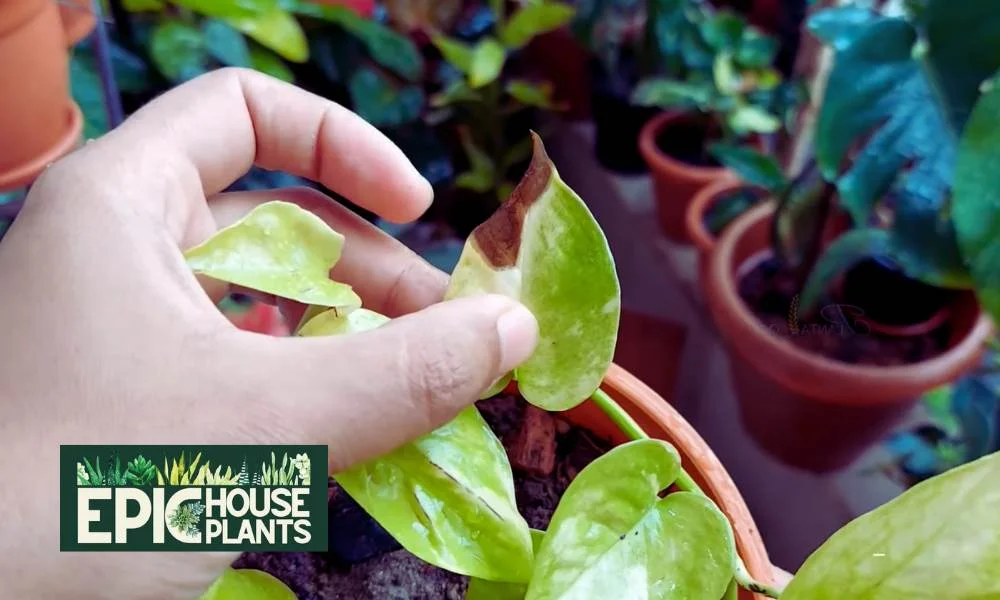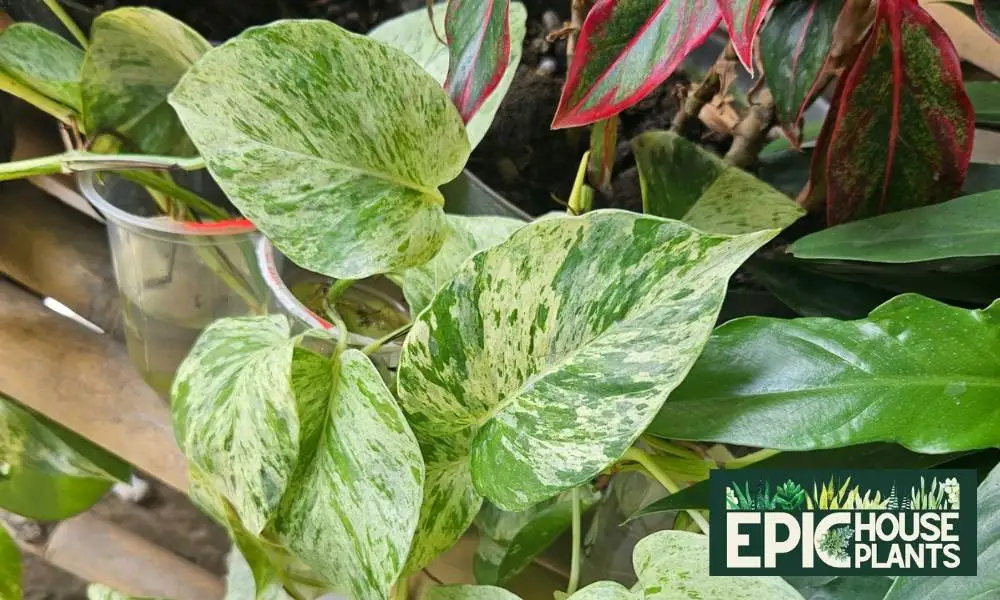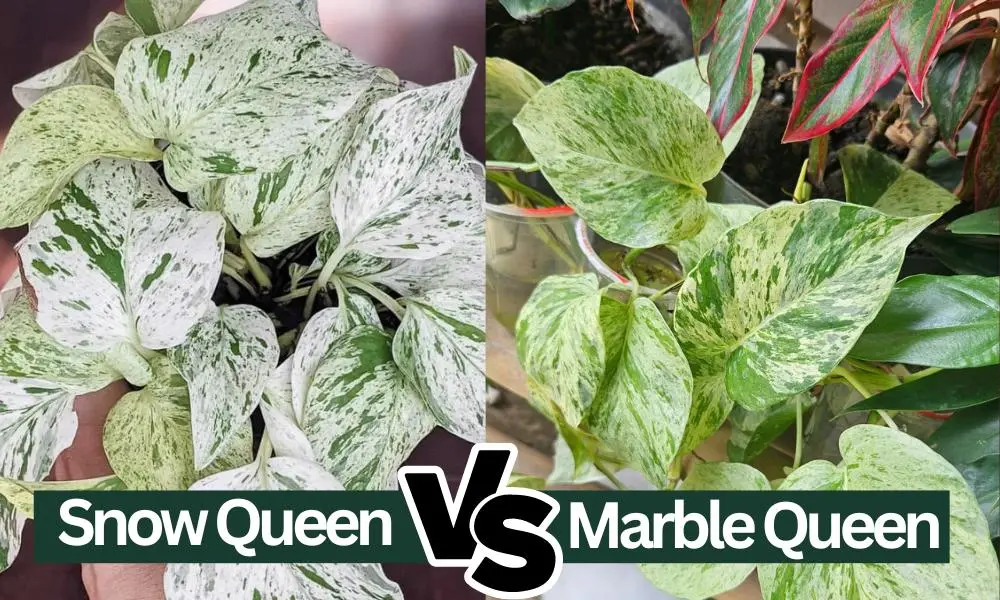Variegated houseplants bring an element of surprise and joy to any interior space. While the classic green houseplants have their charm, variegated varieties stand a notch higher with their playful and spontaneous patterns.
Among the myriad of houseplants, Pothos holds a special place for its diverse and ever-expanding range of variegated species. These varieties are not just visually appealing but are also a testament to the fascinating world of plant cultivation and breeding.
Growing and caring for variegated Pothos is a journey filled with discovery and delight. In this article, we delve into the essentials of nurturing these vibrant plants, alongside a showcase of must-have variegated Pothos types for your home garden.
Get ready to transform your living space with these living splashes of color, each Pothos variety bringing its unique flair and personality.

Variegated Photos Looks Like
Variegated Pothos, known for its striking and attractive foliage, presents a blend of green and white or yellow patterns on its leaves.
Here is the information about Variegated Pothos characteristics presented in a table format:
| Characteristic | Description |
|---|---|
| Leaf Shape and Size | The leaves are typically heart-shaped or elongated and can range from small to medium in size, depending on the variety and growing conditions. |
| Color Variations | The variegation in Pothos can vary widely. Some leaves may have a mix of green with creamy white, yellow, or even light green patches. The pattern of variegation can be marbled, speckled, or in streaks. |
| Leaf Texture | The leaves are usually smooth and waxy, with a glossy finish that enhances the plant’s visual appeal. |
| Growth Pattern | Variegated Pothos plants have a trailing or cascading growth habit, making them ideal for hanging baskets or as climbers. |
| Stem Color | The stems are often green but can have hints of the variegation seen in the leaves, especially in the nodes from where the leaves grow. |
Each variety of Variegated Pothos has its unique pattern. For instance, the ‘Golden Pothos’ has a vibrant yellow and green variegation, while the ‘Marble Queen’ is known for its creamy white and green marbled pattern. The ‘Neon Pothos’ features a bright, almost neon green color, although it’s less variegated compared to others.
These characteristics make Variegated Pothos not only a popular choice for indoor plant enthusiasts but also an attractive addition to any indoor space, adding a touch of nature’s artistry.

Also Read
For more tips on tackling brown tips in pothos, visit our linked article for effective solutions.
What Makes Pothos Variegated?
The variegation in Pothos plants, characterized by the appearance of different colors or tones on the leaves, is primarily a result of genetic factors, environmental influences, and sometimes, a combination of both.
Let’s explore these factors in more detail:
Genetic Factors
The most common reason for variegation in Pothos plants is genetics. In these plants, genetic mutations affect the distribution of chlorophyll in the leaves. Chlorophyll is the pigment responsible for the green color in plants.
In variegated Pothos, some cells lack chlorophyll, revealing the other pigments or the natural color of the plant tissue, which is often white or yellow. This genetic trait can be naturally occurring or induced through selective breeding and cultivation.
Chimeral Variegation
This is a type of genetic variegation where the plant has two or more different types of genetic makeups in its tissues. In Pothos, this can result in sectors of the leaf having different colors – parts with normal chlorophyll content appear green, while those without chlorophyll appear white or yellow.
Environmental Factors
Light levels can influence the intensity and pattern of variegation in Pothos. Adequate light is necessary for the plant to maintain its variegated pattern.
In low light conditions, a variegated Pothos may revert to more green foliage, as the plant produces more chlorophyll to maximize photosynthesis. Conversely, too much direct sunlight can bleach the leaves, affecting the variegation pattern.
Viral Infections
In some plants, not typically Pothos, variegation can be caused by viral infections. However, this is less common and usually not the case with variegated Pothos, which are primarily variegated due to genetic reasons.
Cultural Practices
The propagation method can also influence variegation. For example, variegated plants are often propagated vegetatively (e.g., through cuttings) to maintain the variegation. Seed propagation may not always retain the variegated traits, as these traits might not be stable in the plant’s genetic makeup.
The striking variegation seen in Pothos plants is mainly a result of genetic mutations affecting chlorophyll distribution. The maintenance of this variegation can be influenced by environmental conditions, particularly light levels.
Understanding these factors is key to caring for variegated Pothos, ensuring that they retain their beautiful and distinctive patterns.
Is It Possible Pothos Losing Their Variegation?
Yes, it is possible for Pothos plants to lose their variegation, a phenomenon that can be concerning for plant enthusiasts.
This loss of variegation can occur due to several reasons:
Insufficient Light
One of the most common reasons for Pothos losing its variegation is inadequate light. Variegated plants need more light than their non-variegated counterparts because the non-green, variegated parts of the leaves have less or no chlorophyll, which is essential for photosynthesis.
If a variegated Pothos does not receive enough light, it may revert to producing more chlorophyll, leading to more green leaves in an effort to maximize photosynthesis. This means the plant will gradually lose its variegated pattern.
Genetic Tendency to Revert
Some variegated plants have a natural genetic tendency to revert to their non-variegated form. This reversion happens as the plant attempts to return to a state that allows for more efficient photosynthesis. In Pothos, this can manifest as new growth that is entirely green.
Improper Pruning
If the variegated parts of the plant are pruned excessively, and more of the green, non-variegated parts are left to grow, the plant may start producing more green growth. This is because the green parts of the plant are more efficient at photosynthesis.
Nutrient Imbalance
While less common, an imbalance in nutrients can sometimes affect variegation. A lack of certain nutrients may lead the plant to prioritize chlorophyll production, reducing variegation.
How To Maintain Variegation in Pothos?
Maintaining the variegation in Pothos plants requires specific care to ensure that the plant keeps its beautiful and unique color patterns.
Here is the provided information converted into a table format:
| Care Tips | Description |
|---|---|
| Provide Adequate Light | Variegated Pothos needs bright, indirect light. Avoid direct sunlight. North or east-facing windows are ideal. Consider using grow lights if natural light is insufficient. |
| Avoid Over-Pruning | While pruning is necessary, avoid excessive removal of green parts essential for photosynthesis, especially in variegated plants with less chlorophyll. |
| Proper Watering | Water when the top inch of soil is dry, with good drainage to prevent root rot. Over or underwatering can stress the plant. |
| Balanced Fertilization | Use water-soluble fertilizer during the growing season (spring and summer) to provide nutrients without causing rapid green growth that may reduce variegation. |
| Maintain Consistent Temperatures | Keep temperatures between 60-80°F (15-27°C) to prevent stress from sudden temperature changes. |
| Humidity and Air Circulation | Maintain moderate humidity and good air circulation to promote overall plant health and indirectly support variegation. |
| Regular Monitoring and Care | Keep an eye on the plant for signs of stress or changes in variegation. Early detection allows for timely adjustments in care. |
| Propagation | Propagate variegated parts of the plant if a stem is losing its variegation. Root the stem in water or soil to preserve and increase variegated foliage. |
| Avoid Chemical Stress | Limit the use of harsh chemicals or pesticides, opt for gentle, natural solutions like neem oil or insecticidal soap to avoid stressing the plant. |
By following these care tips, you can help ensure that your Variegated Pothos retains its striking patterns and continues to thrive in your indoor space. Remember, each plant is unique, and observing how your specific Pothos responds to its environment is key to providing the best care.
13 Variegated Pothos Varieties You Should Grow
Variegated Pothos are popular houseplants due to their striking foliage and easy care requirements. Here are some beautiful variegated Pothos varieties that you should consider growing:
1. Golden Pothos (Devil’s Ivy)

The Golden Pothos, also known as Devil’s Ivy, is the undisputed king (or queen!) of the pothos world. Its popularity stems from its effortless charm and easy-going nature. Imagine glossy, heart-shaped leaves in a deep shade of green, splashed generously with vibrant golden yellow variegation.
This striking contrast creates a lively pattern that instantly brightens any space. But its beauty isn’t just skin-deep. This pothos thrives in low light conditions, making it perfect for homes with limited natural illumination. It’s also tolerant of occasional neglect, forgiving you if you forget to water it every now and then.
So, whether you’re a seasoned plant parent or a complete beginner, the Golden Pothos is an ideal choice to add a touch of lush greenery and low-maintenance vibrancy to your life.
2. Marble Queen Pothos

The Marble Queen Pothos lives up to its name with a stunning variegation that resembles a masterpiece crafted from creamy white and emerald green swirls. Unlike the bold splashes of the Golden Pothos, the Marble Queen’s variegation is a delicate dance of light and shadow, creating a mesmerizing pattern that adds a touch of elegance to any room.
While it prefers moderate light to maintain its stunning marbling, it can tolerate lower light conditions as well. Just keep in mind that the variegation might be less pronounced.
Compared to the Golden Pothos, the Marble Queen requires slightly more attention in terms of watering and humidity. But its unique beauty and air of sophistication make it worth the extra effort.

Also Read
If you’re curious about the differences between Snow Queen and Marble Queen Pothos, be sure to check out our comparison article here: Snow Queen vs Marble Queen Pothos
3. Manjula Pothos

The Manjula Pothos is like a kaleidoscope of green, capturing your attention with its playful variegation. Imagine large, heart-shaped leaves adorned with a mesmerizing mix of creamy white, light green, and emerald splashes.
This variety offers endless variations in its variegation patterns, making each plant a unique work of art. It thrives in moderate to bright indirect light and adds a touch of personality and vibrancy to any space. Compared to the Golden Pothos and Marble Queen, the Manjula might be slightly trickier to care for.
It prefers consistent moisture and slightly higher humidity levels. But its fast-growing nature and ever-changing foliage make it a rewarding choice for plant enthusiasts who enjoy a bit of a challenge.
4. NJoy Pothos

This cheerful charmer offers a delightful twist on the classic pothos aesthetic. Picture dainty heart-shaped leaves painted in a playful dance of bright white and vibrant green. The variegation tends to be more concentrated on the edges, creating a charmingly “marcoed” effect.
Unlike some heavily variegated pothos, the N’Joy thrives in moderate to bright indirect light, making it adaptable to various lighting conditions. It’s also known for its relatively slow growth, allowing you to savor its beauty as it gracefully extends its vines.
5. Variegated Neon Pothos

Forget about shades of grey, this pothos blasts a neon party into your living space! Its elongated leaves shimmer with a striking chartreuse or lime green hue, devoid of any dark green.
This vibrant energy makes it a standout choice for adding a pop of sunshine and tropical flair to any room. Just like the N’Joy, it prefers bright indirect light to maintain its electrifying color.
While faster-growing than the N’Joy, it’s still considered a relatively slow-growing pothos, allowing you to appreciate its unique foliage as it unfurls.
6. Snow Queen Pothos

This rare gem is like a winter wonderland captured in greenery. Imagine heart-shaped leaves blanketed in a thick layer of pristine white, leaving only hints of emerald green peeking through.
The Snow Queen requires bright light to maintain its stunningly pale complexion, and it might be a bit more demanding in terms of care compared to its hardier cousins. But for those who love a delicate beauty and are willing to put in the extra effort, the Snow Queen’s ethereal radiance is a sight to behold.
7. Harlequin Pothos

This pothos throws out a bold and unpredictable color palette, like a mischievous artist throwing paint at a canvas. Its leaves can showcase a mix of white, yellow, light green, and even specks of pink, creating a unique and ever-changing pattern.
Imagine a mosaic of vibrant shades dancing across the foliage, making it a true conversation starter in any room.
Like many other variegated pothos, the Harlequin thrives in moderate to bright indirect light and requires slightly more attention in terms of watering and humidity compared to its simpler counterparts. But its quirky charm and unpredictable variegation make it a captivating choice for adventurous plant enthusiasts.
8. Glacier Pothos

This pothos shimmers with the coolness of its namesake, sporting elongated leaves in a mesmerizing blend of silvery-green and jade. The variegation appears as streaks and speckles of lighter green, adding depth and dimension to the foliage.
Like a majestic glacier carved by time, the Glacier Pothos thrives in moderate to bright indirect light and prefers slightly higher humidity levels. Compared to some pothos, it might require a bit more attention to watering needs, but its elegant and sophisticated aura makes it a worthy investment.
9. Variegated Cebu Blue Pothos (Epipremnum Pinnatum Albo)

This pothos isn’t afraid to break the mold, ditching the traditional heart-shaped leaves for cascading tendrils adorned with stunningly elongated, narrow foliage.
The leaves boast mesmerizing shades of blue-green and silver, adding an exotic touch to any space. This unique variety thrives in moderate to bright indirect light and appreciates a bit more humidity than its less demanding cousins.
While its growth can be slightly slower than other pothos, its graceful tendrils and captivating color palette make it a true showstopper.
10. Pearls and Jade Pothos

Step into a fairytale forest with this enchanting pothos. Imagine delicate heart-shaped leaves painted in a symphony of emerald green, adorned with tiny splashes of creamy white that resemble scattered pearls.
This subtle yet captivating variegation adds a touch of whimsy and elegance to any room. The Pearls and Jade is relatively easy to care for, thriving in moderate to bright indirect light and tolerating occasional neglect.
Its dainty leaves and charming variegation make it a wonderful choice for those who seek a touch of fairytale magic in their homes.
11. Jessenia Pothos

This pothos is a true giant in the making, boasting the potential for incredibly large leaves that can reach up to a foot in width! Imagine these massive emerald canvases splashed with stunning variegation ranging from light green to almost golden-white.
The Jessenia requires slightly more care than other pothos, preferring consistent moisture and bright indirect light. But its majestic size and unique variegation make it a rewarding challenge for plant enthusiasts who enjoy nurturing a statement piece.
12. Hawaiian Pothos

This pothos brings a taste of tropical paradise to your living space. Picture heart-shaped leaves showcasing a vibrant mix of green, yellow, and white variegation, often in streaks and speckles that resemble sunlight filtering through lush foliage.
The Hawaiian Pothos thrives in moderate to bright indirect light and adds a touch of sunshine and vibrancy to any room. However, its variegation can be slightly less pronounced in lower light conditions.
Compared to some pothos, it might require a bit more attention to watering and humidity, but its tropical flair and cheerful vibes make it a worthwhile addition to any plant collection.
13. Lemon Meringue Pothos

This newcomer to the pothos scene is already making waves with its delightful color combination. Imagine lush green leaves sprinkled with vibrant splashes of sunshine yellow, resembling a slice of its namesake dessert.
The variegation tends to be concentrated on the edges, creating a charmingly “framed” effect. Like its golden cousin, the Lemon Meringue thrives in moderate to bright indirect light and is relatively easy to care for.
Its cheerful hues and playful variegation make it a perfect choice for adding a touch of sunshine and lightheartedness to any space.
Author

Pudji Haryanto
Pudji Haryanto is a writer and urban farmer with a passion for cultivating plants. He has over 15 years of experience in agriculture and currently manages a 65,000 square foot rice-field and yard filled with various plants, including vegetables, spices, flowers, and garden plants.
